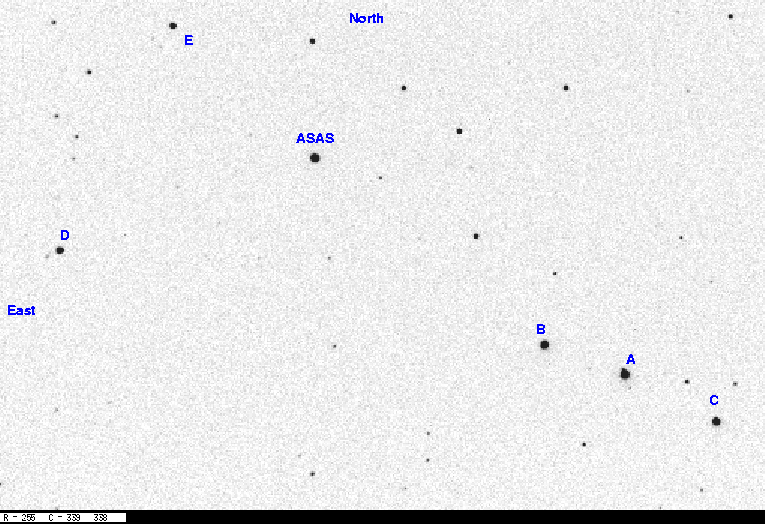
On the night of Sept 26/27, 2004 EDT, Tracy Davis and I used the RIT Observatory's 12-inch Meade telescope and SBIG ST8 CCD camera to monitor the cataclysmic variable star ASAS 002511; it's under study by the Center for Backyard Astrophysics. I also tried using our PC-164C video camera on a small telescope attached to our 16-inch telescope, as a finder for the big telescope.
The plan:
Notes from the night
Here's a chart of the field of ASAS 002511 taken on Sep 18, 2004. The field is about 20 arcminutes wide. Click on the picture for a larger version.
Arne Henden's calibration of stars in the field indicates
I measured the instrumental magnitude of each star with aperture photometry, using a radius of 5 pixels = 9.3 arcseconds, and sky defined by an annulus around each star. Following the procedures outlined by Kent Honeycutt's article on inhomogeneous ensemble photometry, I used all stars available in each image to define a reference frame, and measured each star against this frame.
Below is a graph of the scatter in differential magnitude versus magnitude. Note that the brightest stars included in the solution may be slightly saturated. I made a series of preliminary solutions and discarded stars which had large scatter due to close companions, or due to their position near the edge of the frame, etc.

ASAS 002511 is the bright star with the larger-than-normal scatter in this diagram. The brightest stars (of mag V=11.2 and 11.5) have a formal scatter of 0.003 and 0.005 mag, respectively.
Light curves for selected stars in the field are shown below. ASAS 002511, in green, is clearly variable.

Here's a closeup of the variation in ASAS 002511 itself:
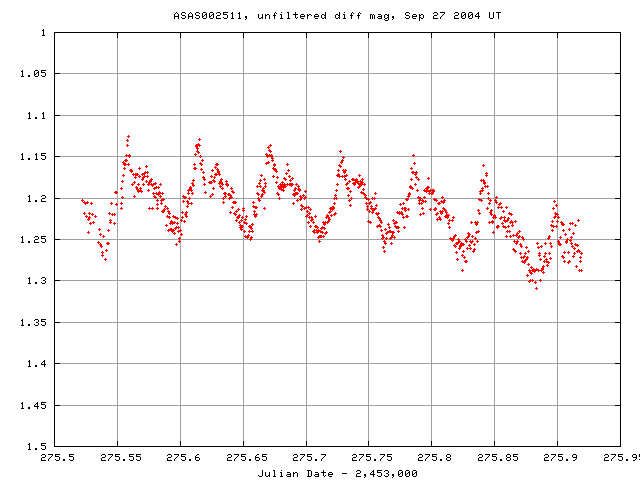
The shape of the light curve has clearly changed since our last measurements one week ago. As other CBA members have noted, there is a sharp but brief primary maximum, followed by a sharp drop and then (about a half-hour after the primary maximum) a sharp secondary maximum.
I've made a table of the measurements themselves, with three different flavors of time. The differential unfiltered magnitudes from the ensemble solution has been shifted so that star "B" in my chart, GSC 559-1272, has value 11.485, matching its V-band magnitude as determined by Arne Henden.
Here's the start of the table:
# Measurements of ASAS002511 made at RIT Obs, Sep_ 27, 2004 UT, # made by Michael Richmond and Tracy Davis. # All data taken with 12-inch LX-200 + no filter + SBIG ST-8 CCD # no focal reducer, so at native f/10 # Each exposure 15 seconds long; the tabulated times are midexposure # and accurate only to +/- 1 second. # 'mag' is a differential magnitude based on ensemble photometry # which has been shifted to star GSC 599-1272 has mag=11.485 # (matching Henden's calibration of the star to V=11.485) # # UT day JD-2,450,000 HJD-2,450,000 mag Sep_27.02233 3275.52233 3275.52801 12.269 Sep_27.02352 3275.52352 3275.52920 12.271 Sep_27.02390 3275.52390 3275.52958 12.285
Anthony Kroes, another CBA member, observed this system on the same night. Let's see how well our measurements agree. Our system:
Anthony Kroes' system:
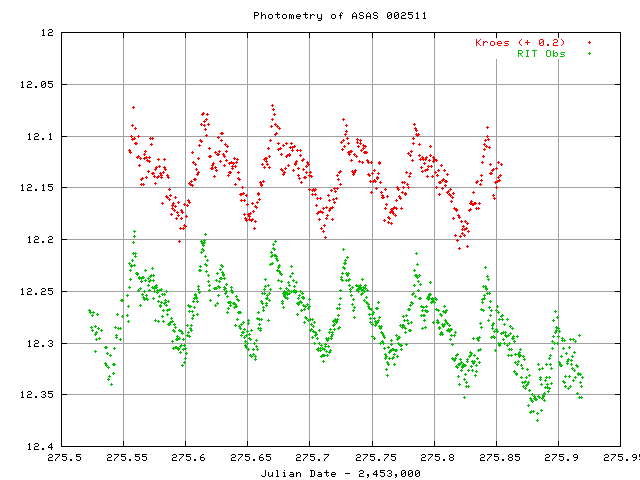
Just for fun, for a more quantitative comparison, I created interpolated versions of both datasets on a common timescale (using simple linear interpolation between neighboring data). I then computed the difference between the RIT measurements and Kroes' measurements at each common time. Here are the results:
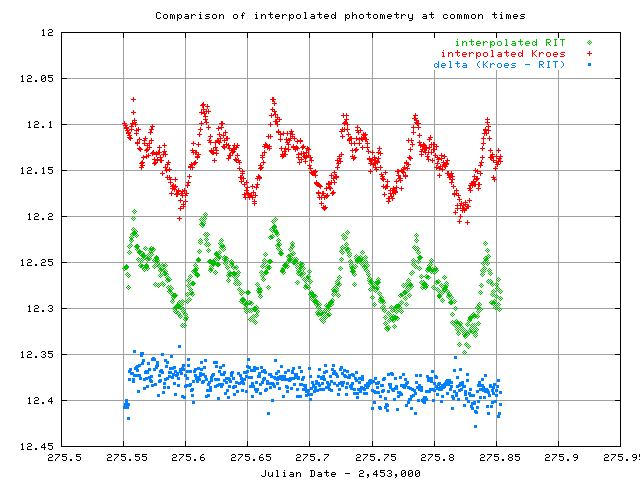
There's a clear slope in the differences, which is undoubtedly caused by atmospheric extinction affecting the target star and comparison stars slightly differently (and exacerbated by any color terms between our cameras). If I fit a line to the residuals, I find a formal scatter around the fit of 0.011 magnitudes. Pretty good agreement, I'd say ....
We've had some trouble locating faint targets with our 16-inch telescope in the past, especially when using a detector with a very small field of view: the ToUCam, for example, has a field less than 2 arcminutes on a side. The regular finder doesn't provide a fine enough location to place the target on the detector, which can be very frustrating.
So, I thought, why not add one more step between the large field of the 8x50 finder and the teeny-tiny field of view of the main camera? I fixed an Orion Short Tube 80mm f/5 refractor onto the tube of the big telescope, then put a SuperCircuits PC-164C video camera at the focus of the little refractor. I had to use a 1-1/4 inch extension tube to move the camera far enough from the refractor to reach focus. As a rough guide, one should rotate the camera so that as one looks at it from the side, the word "SuperCircuits" appears near the bottom of the visible barrel.
I then pointed the telescope at a field near the star xi Aql, which just happened to be nicely near meridian. A bright, nearly full moon was about 50 degrees away and low on the eastern horizon, but the sky was clear. Here's a chart of the field, thanks to XEphem.
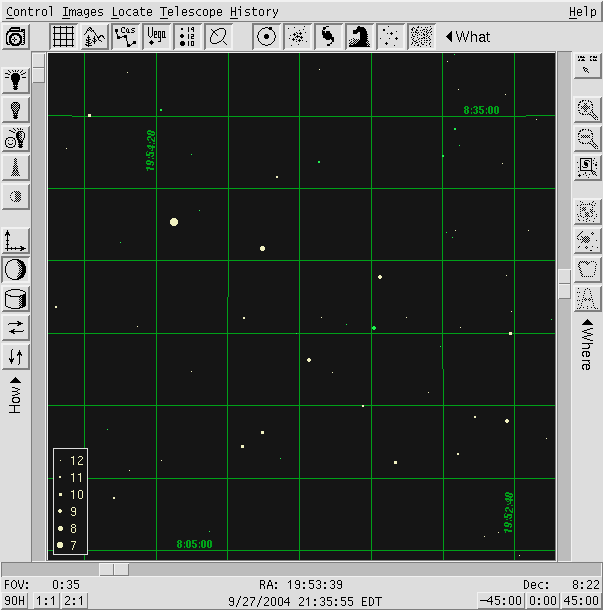
The bright star at upper left is xi Aql, magnitude V=4.7. Note the triangle of stars to its lower right and the fainter pair of stars near bottom center.
The questions are:
When I plugged the video output into a television monitor at the observatory, I was able to see at least 6 or 7 stars. In order to make a record, I sent the video output to a (cheap) video digitizer PC-MCIA card in a (balky) old laptop. The digitizer did not show stars as faint as the TV monitor, but here's one captured image:
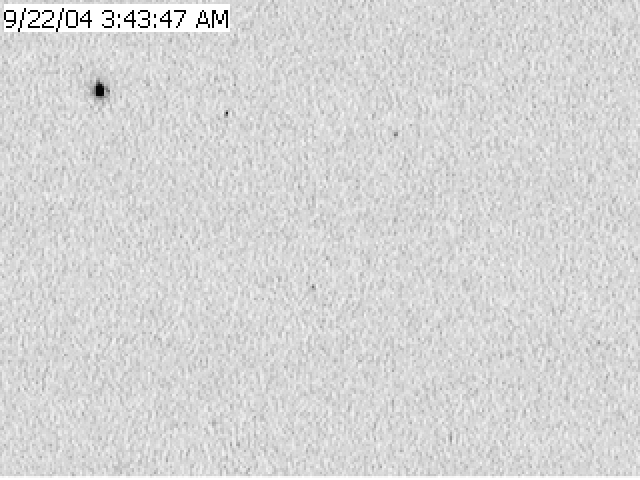
I've magnified the 320x240 image by a factor of two and fiddled with the contrast and gamma factor to try to bring out the objects I could see on the monitor, but it's still far worse. Hmmm. Let me convert a set of 7 JPEG images to FITS and then take the pixel-by-pixel median of the set ...
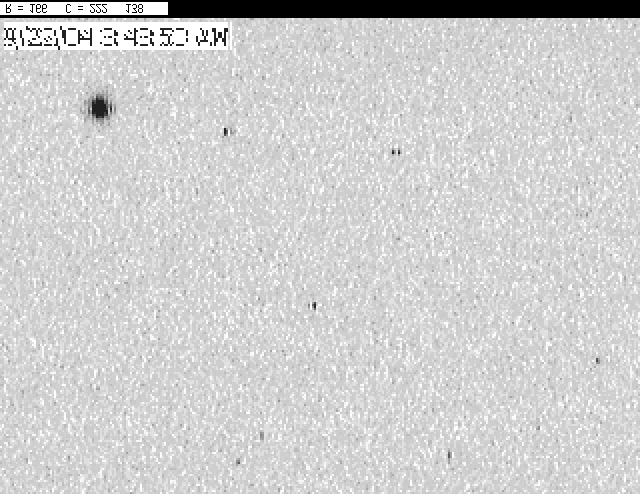
Here are the stars I can see in the median image; they correspond roughly to the objects I could detect on the TV monitor last night.
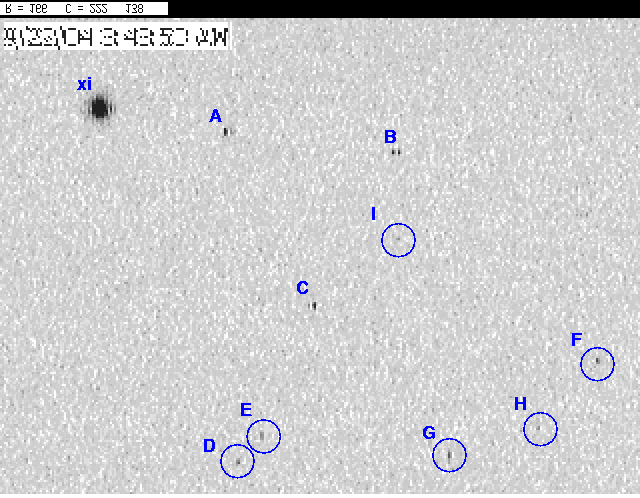
Most of the stars here are in the Tycho-2 catalog.
Star Bt Vt ------------------------------------------------------------------- xi 6.0 4.8 A 9.9 8.5 B 10.3 9.0 C 8.7 8.7 a rather blue star D 11.8 10.1 E 9.6 9.5 another blue star F 11.6 9.9 G 9.6 9.5 blue again H 10.9 10.1 I 10.9 10.4 may be blend with faint galaxy -------------------------------------------------------------------
My notes from last night show that I saw both D and E clearly on the screen, and G as well. That means the limiting magnitude is somewhere around V=9 to V=10 --- pretty good. The plate scale is about 5.77 arcseconds per pixel; thus, the field of 320x240 pixels would be about 31x23 arcminutes.
Hmmmm. I can try to estimate the readout noise of the PC-164C CCD chip with this data. A simple signal-to-noise calculation indicates that the readout noise must be in the vicinity of 30 electrons RMS; I guess that makes sense, but I could measure it next time....
In any case, I think that this will help us to put a target into field of view of a small detector on the 16-inch in the future.
Last modified 9/28/2004 by MWR.